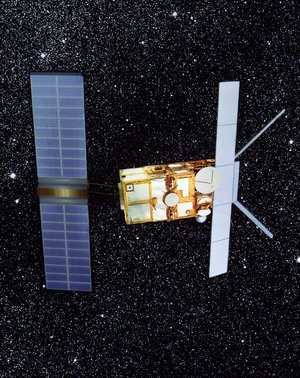New tool for weather forecasters
A new processing system now operational in ESA ground stations will help weather forecasters to benefit once more from unique all-weather data from the ERS-2 scatterometer.
Although the highly successful ERS global mission is formally over, the spacecraft has been continuing to provide coverage over the north Atlantic.
Weather experts are keen to continue to receive data from its wind-measuring instrument, the C-band scatterometer. This instrument is unique in the sense that it is not affected by rain and can provide data day or night in all conditions. So experts can get data just when they need it most – in bad weather!

The European Centre for Medium-Range Weather Forecasts (ECMWF) is especially interested in using this data for measuring winds and waves over the north Atlantic.
“The ERS-2 scatterometer is particularly useful in the early detection of Atlantic hurricanes and extreme winter storms,” says Philippe Bougeault, head of the Research Department at ECMWF. “It offers a unique opportunity to provide marine users, such as operators of ships and oil platforms, with timely and accurate information on marine weather and waves.” “ERS scatterometer winds are not affected by rain, and have proven to give valuable information near intense cyclones and in baroclinic regions”, explains ECMWF’s ocean-wave expert Hans Hersbach.
The scatterometer data has not been available to the user community since 2001 when the spacecraft’s gyros failed. An innovative rescue in January of that year enabled ERS-2 to keep flying without the vital stabilising gyroscopes, prolonging the lifetime of many of the instruments. However, although the scatterometer continued to take measurements, this key wind data could no longer be processed by forecasters.
Experts at ESA’s research centre in Italy immediately began looking for ways to retrieve the precious information. Preliminary studies were encouraging, specialists in industry got the go-ahead to develop a software tool to compensate for the degraded satellite attitude and generate the scatterometer measurements from the raw data.
The Belgian Royal Military academy (RMA) designed the new ESACA processor, while Spacebel in Belgium produced the engineering code and Spacetec, Norway, had the task of integrating the new system on the ground, at the three ground stations in Kiruna (Sweden), Maspalomas (Canary Islands) and Gatineau (Canada), as well as the reference station at ESA/ESRIN in Frascati (I). An installation at an additional station in West Freugh (Scotland) will follow shortly, to optimise coverage of the north Atlantic.

The new tool does more than it was asked for. While the original scatterometer was intended to provide wind measurements over sea, a number of new and previously unforeseen applications have emerged – covering not only wind, but also land, sea ice, soil moisture and vegetation measurements.
The software algorithm will also be used to reprocess the mountain of archived ERS-1 and -2 scatterometer data. The continuity of these observations offered by ERS since 1991 is invaluable to researchers involved in long-term studies on climate cycles. They already have their eye on the future – Europe’s MetOp.
The new processor is operational this week, good news for forecasters as the cyclone season approaches.
Notes for editors
ERS
The first European remote-sensing satellite ERS-1 was launched by Ariane-4 in July 1991. Its near-twin ERS-2 was launched on 21 April 1995. The suite of instruments onboard these two highly successful satellites, have collected a wealth of valuable data on the Earth’s land surfaces, oceans, and polar caps. Both satellites continued to provide data well beyond their original lifetime. ERS-1 completed its operation in 2000. Although its global mission is formally over, ERS-2 continues to provide data over the north Atlantic region.
MetOp
MetOp will be Europe's first polar-orbiting satellite dedicated to operational meteorology. It represents the European contribution to a new cooperative venture with the United States providing data that will be used to monitor our climate and improve weather forecasting.
A new generation of European instruments that offer improved remote sensing capabilities to both meteorologists and climatologists will be carried with a set of 'heritage' instruments provided by the United States. The new European instruments will augment the accuracy of:
- temperature and humidity measurements
- wind speed and wind direction measurements, especially over the ocean
- profiles of ozone in the atmosphere
MetOp is a series of three satellites to be launched sequentially over 14 years, starting in 2005, and forms the space segment of EUMETSAT's Polar System (EPS).







